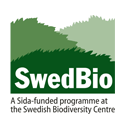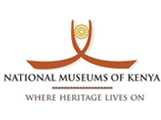Species in the Genus
Species in Kenya, Tanzania & Uganda
Description
Possible Causes of Confusion
Distribution in Kenya, Tanzania & Uganda
Habitats
Nesting
Crops Visited
Other Plants Visited
Economic / Ecological Importance
Threats
Conservation and Management Practices
Legislation (National and International)
References
Editors
Acknowledgements
Contact
Click on images to enlarge

Pseudapis species. ©Bernhard Jacobi

Pseudapis diveripes. ©John Ascher, 2006-2010 / www.discoverlife.org
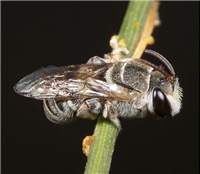
Pseudapis nilotica. ©Bernhard Jacobi
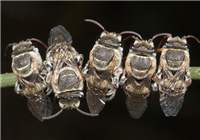
Pseudapis nilotica. ©Bernhard Jacobi
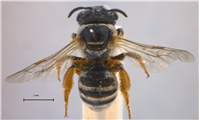
Pseudapis species (female) - pinned specimen. Photo: Connal Eardley

Pseudapis species (male) - pinned specimen. Photo: Connal Eardley
Summary
Honey bees are not the only bee species that are significant for human wellbeing. Pseudapis bees are a group of native bee species that do not produce honey but are likely to be important pollinators of crops and wild plants. Females have a sting, but they are not aggressive and will only sting if handled. These ground-nesting bees live independently (i.e. they are solitary). This fact sheet provides information about these bees to encourage farmers to understand and protect them to help ensure that their crops are effectively pollinated.
From a conservation and agricultural standpoint it is not necessary to recognise all the different bee genera. However, it is important to know that there is a large bee biodiversity. Different bee genera pollinate different plant species, although there is some overlap that acts as a buffer as bee populations wax and wane. For healthy ecosystems, including agro-ecosystems both diversity and abundance in the bee fauna is important.
Scientific Classification
Kingdom: Animalia
Phylum: Arthropoda
Class: Insecta
Order: Hymenoptera
Family: Halictidae
Subfamily: Nomiinae
Genus: Pseudapis Kirby, 1900
Species in the Genus
There are about 70 named species of Pseudapis bees known from different parts of the world, particularly from Africa, Europe,
Species in Kenya, Tanzania & Uganda
Twelve species of Pseudapis bee have been recorded in
Description
Pseudapis bees are not well known by local people (including farmers) in
Possible Causes of Confusion
Pseudapis bees are similar other species in the family Halictidae especially Nomia bees . They can be distinguished with Pseudapis bees having a large tegula (the scale covering base of fore-wing) and pale bands on the abdomen .
Distribution in Kenya, Tanzania & Uganda
Pseudapis bees occur in different agro-ecologies in East Africa. They can be found in all regions.
Habitats
They will be found in all habitats as long as their nests foraging sites are protected. In absence of these, their existence in those regions is not guaranteed.
Nesting
Pseudapis bees are solitary and prefer to nest in soils.
Crops Visited
There is not much information about crop pollination by Pseudapis bees. However, they have been reported as flower visitors of cashew, eggplants and crops belonging to Asteraceae (Compositae) family.
Other Plants Visited
Pseudapis bees have been reported to visit, the screw tree (Helicteres isora) and wild plants belonging to family Asteraceae.
Economic / Ecological Importance
Little information exists on the usefulness of these bees to the lives of the people in
Threats
In
Conservation and Management Practices
There are now concerted research efforts in the region to develop best practices for conservation and management of bees to enhance crop production. Theoretically, bee conservation and management is inexpensive and adopted activities can also improve the aesthetic value of the landscape. Such practices involve setting land aside (e.g. a 1-metre strip) in the farmland to host all year round food resources for the bees, as well as safer sites for nesting, mating, resting and refuge from natural enemies. During flowering, farmers should manage pesticide usage carefully to avoid poisoning flower-visiting bees. Farmers should also minimise pesticide drift from the field to adjacent areas. Laws governing registration and use of plant protection products indirectly play a major role in the protection of pollinators. Trampling by people and livestock and tilling should be managed to conserve the nesting sites of soil-nesting species. KARI (the Kenya Agricultural Research Institute) is developing protocols for mass rearing of different species of solitary bees. Any successful results from this research will be freely communicated to the public. In addition, KARI is collaborating with other stakeholders to ensure in situ conservation and management of bees for pollination purposes. Much of the work of conserving native bees will be underpinned by raising public awareness of the importance of these species.
Legislation (National and International)
There is not yet any legislation in
References
1. Atluri JB, Rao SP, and Reddi CS (2000) Pollination ecology of Helicteres isora Linn. (Sterculiaceae). Current Science 78 (6): 713-718
2. Eardley CD, Kuhlmann M and Pauly A. (2010) The Bee Genera and Subgenera of sub-Saharan Africa. ABC Taxa vol 7: i-vi, 138 pp. http://www.abctaxa.be/volumes/vol-7-bees
3. Eardley CD and Urban R (2010) Catalogue of Afrotropical bees (Hymenoptera: Apoidea: Apiformes). Zootaxa, 2455: 1–548.
4. Michener CD (2007) The Bees of the world, the John Hopkins University Press, Baltimore and London, pp 913.
5. Sundararaju D (2000) Foraging behaviour of pollinators on cashew. Cashew 14 (4): 17-20
6. Pauly, A. (1990) Classification des Nomiinae africains (Hymenoptera Apoidea Halictidae). Musée Royal de l’Afrique Centrale Tervuren, Belgique. Annales Sciences Zoologiques, 261, 1–206.
Editors
Théodore Munyuli, Busitema University - Uganda; Muo Kasina, Kenya Agricultural Research Institute (KARI) - Kenya; Juma Lossini, Tropical Pesticides Research Institute (TPRI) – Tanzania; John Mauremootoo, BioNET-INTERNATIONAL Secretariat – UK; Connal Eardley, Plant Protection Research Institute (PPRI) – South Africa.
Acknowledgements
We recognise the support from the Kenya Agricultural Research Institute (KARI), Tropical Pesticide Research Institute (TPRI) –
Contact
BioNET-EAFRINET regional coordinator: [email protected]





